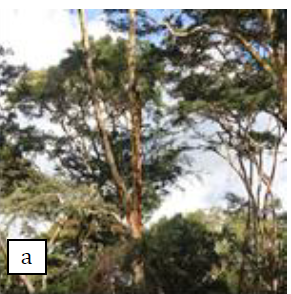Stand and Site Characteristics of Kabesak (Acacia leucophloea) in Timor Island, East Nusa Tenggara, Indonesia

Kabesak (Acacia leucophloea) is a particular plant species and recognized to have important benefits tothe local people of Timor Island. The people of Timor Island use kabesak leaves as animal feed in the dry season and kabesak wood is used as building materials and furniture. The purpose of this study wasto determine the stand and site characteristics ofkabesak in the western region of Timor, Indonesia. The means of density, frequency, dominance, and importance value index were analyzed. The results showed kabesak stand structure in secondary forest land, grassland, and shrubs, as well as garden showed the J-inverted shaped, which implies that natural regeneration was a proper continuation. Kabesak had significant associations with a few plants’ species, both negative and positive types. The result of regression analysis of the principal components showedthat the contribution of edaphic factor influencesthe population density of kabesak.Silt fraction and phosphorus content were found tohave the highest positive effect on the density, while sand fraction and sodium content were found to havethe highestnegative effectsof kabesak. A test for altitude with Tukey test (α = 0.05) reveals that kabesak from 0-300 m a.s.l., 300-600 m. asl., 600-900 m a.s.l. werenot different from each other, while altitude >900 m a.s.l. was significantly different from the other groups.
Antos,J.A., Filipescu,C.N.,&Negrave, R.W. (2016). Ecologyof western redcedar (Thuja plicata): Implications for management of a high-value multiple-use resource. ForestEcologyand Management375: 211-222.
Arthanarieswaran,V.P., Kumaravel,A.,&Saravanakumar,S.S. (2015). Characterization of new natural cellulosicFiber from Acacia leucophloea bark. InternationalJournalofPolymerAnalysis andCharacterization20(4): 367-376.
[Balittanah] Badan Penelitian Tanah. (2009). Petunjuk teknis: analisis kimia tanah,tanaman, air dan pupuk. Jakarta: Departemen Pertanian.[Indonesian]
Baker,P.J., Scowcroft,P.G.,&Ewel J.J. (2009).Koa(Acacia koa) ecology and silviculture. Gen. Tech. Rep. PSW-GTR-211. Department of Agriculture, Forest Service, Pacific Southwest Research Station, Albany, CA.
Botequim,B., Zubizarreta-Gerendiain,A., Garcia-Gonzalo,J., Silva,A., Marques,S., Fernandes,P.M., Pereira,J.M.C.,&Tome,M.(2015). A model of shrub biomass accumulation as a tool to support management of Portuguese forests. iForest -Biogeosciences and Forestry,8, 114-125. doi:10.3832/ifor0931-008
Clark,A.L.,&Clair S.B.S. (2011). Mycorrhizas and secondary succession in aspen–conifer forests: Light limitation differentially affects a dominant early and late successional species. ForestEcologyand Management262,203-207.
Djufri. (2004). Acacia nilotica(L.) Willd. ex Del. dan permasalahannya di Taman Nasional Baluran Jawa Timur..Biodiversitas,5(2),96-104.
Fonseca,T.F.,&Duarte,J.C.(2017). A silvicultural stand densitymodel to control understory in maritime pine stands. iForest -Biogeosciences andForestry,10,829-836. doi: 10.3832/ifor2173-010 [online2017-09-25]
Fortini,L.B,. &Zarin,D.J. (2011). Population dynamics and management of Amazon tidal floodplain forests: Links to the past, present and future. ForestEcology andManagement,261,551-561.
Fuentes-Ramirez,A., Pauchard,A., Cavieres,L.A.,&Garcia,R.A. (2011). Survival and growth of Acacia dealbatavs. native trees across an invasion front in South-Central Chile. ForestEcology andManagement,261,1003-1009.
Gallegos,S.C., Beck,S.G., Hensen,I., Saavedra,F., Lippok,D., & Schleuning,M. (2016). Factors limiting montane forestregeneration in bracken-dominated habitats in the tropics. Forest Ecology and Management,381,168-176.
Heyne,K. (1987).Useful plants of Indonesia Jilid ke-3.: Jakarta: BadanPenelitian dan Pengembangan Kehutanan, Departemen Kehutanan.[Indonesian]
Hardjowigeno,S. (1992). Soil Science. Jakarta:PT Melton Putra.[Indonesian]
Herrero-Jauregui,C., Sist,P., & Casado,M.A. (2012). Populationstructure of two low density neotropical tree species under different management systems. Forest Ecology and Management,280: 31-39.
Hidayat,S. (2014). Kondisi vegetasi di Hutan Lindung Sesaot, Kabupaten Lombok Barat,Nusa Tenggara Barat, sebagai informasi dasar pengelolaan Kawasan. JurnalPenelitian Kehutanan Wallacea, 3(2), 97-105.
Imran,I., Hussain,L., Zia-Ul-Haq,M., Janbaz,K.H., Gilani,A.H.,&De Feo,V. (2011). Gastrointestial and respiratory activities of Acacia leucophloea.Journalethnopharmacol,138(3),676-682.
Kai,M., Genyou,L., Leijie,Z., Caixia,Y., & Houhua X. (2013). Populationstructure and distribution patterns of the rare and endangered Ardisia violacea(Myrsinaceae). Acta Ecologicasinica,33,72-79.
Karyati., Ipor,I.B., Jusoh,I.,&Wasli,M.E. (2017). The diameter increment of selected tree species in a secondarytropical forest in Sarawak, Malaysia. Biodiversitas,18(1),304-311.
Krebs,CK. (2002).Ecological methodology.Ed ke-2. New York: Harper & Row Publisher.
Krisnawati,H., Kallio,M.,&Kanninen,M. (2011). Acacia mangium Willd. Ecology, silviculture and productivity. Bogor: Center for International Forestry Research(CIFOR).
Kurniawan,A., Unduharta,N.K.E., & Pendit,I.M.R. (2008). Association of dominant tree species in lowland forest Tangkoko Nature Reserve, Bitung, North Sulawesi. Biodiversitas,9(3),199-203.
Kusmana,C. (1997). Metode survei vegetasi.Bogor:Institut Pertanian Bogor(IPB).
Li,W., & Zhang G.F. (2015). Population structure and spatial pattern of the endemic and endangered subtropical tree Parrotia subaequalis(Hamamelidaceae). Flora,212,10-18.
Midgley,J.J., Lawes,M.J., & Chamaille-Jammes,S. (2010). Savannawoody plant dynamics: the role of fire and herbivory, separately and synergistically.AustralianJournal of Botany,58,1-11.
Muhdin, Suhendang,E., Wahjono,D., Purnomo,H., Istomo., & Simangunsong B.C.H. (2008). Keragaman struktur tegakan hutan alam sekunder. Jurnal Manajemen Hutan Tropika2,81-87.[Indonesian].
Mueller-Dombois,D., & Ellenberg,D.H. (1974). Aims and methods of vegetation ecology. New York:John Wiley & Sons, Inc.
Njurumana,G.N. (2015). Ekologi sosial pilang (Acacia leucophloea) di Kabupaten Timor Tengah Selatan, Nusa Tenggara Timur. In: Setyawan A.D, Sugiyarto, Pitoyo A, Hernawan U.E, Sutomo, Widiastuti A, Raqib S.M, Suwandhi I, Rosleine D(eds). Proceeding of National Seminary Indonesian Biodiversity Comunnity. Bandung, 13 June 2015.[Indonesia]
[NFTA]. (1996). Acacia leucophloea -shade and fodder for livestock in arid environments. NFTA 96-04. www.nzdl.org/gsdlmod
Prior,L.D., McCaw,W.L., Grierson,P.F., Murphy,B.P., & Bowman,D.M.J.S. (2011). Population structures of the widespread Australian conifer Callitris columellarisare a bio-indicator of continental environmental change. Forest Ecology and Management,262,252 -262.
Rianawati,H. (2014). Studi kelas kuat kayu kabesak (Acacia leucophloea(Roxb.) Willd.). Majalah Warta Cendana,7(2),1-5.
Riwu-Kaho, N. (2010). The relationship between free grazing & forestfire frequency to the Eucalyptus urophylla(Ampupu) standsin Mount Mutis Nature Reserve, West Timor, East Nusa Tenggara. [Thesis]. Gadjah Mada University, Yogyakarta.
Shankar,U. (2001). A case of high tree diversity in sal(Shorea robusta) dominated lowland forest of Eastern Himalaya: floristic composition, regeneration, and conservation. CurrentScience,81(7),776-786.
Sowndhararajan,K., Joseph,J.M., & Manian,S. (2013). Antioxidant and free radical scavenging activities of Indian Acacias: Acacia leucophloea(Roxb.) Willd., Acacia FerrugineaDc., Acacia DealbataLink. and Acacia Pennata(L.) Willd,. International JournalofFood Properties,16(8),1717-1729.
Suarez,M.L.,&Kitzberger,T. (2008). Recruitment patterns following a severe drought: long-term compositional shifts in Patagonian forest. Canadian Journal of Forest Research,38,3002-3010.
Tang,C.Q., Yang,Y., Ohsawa,M., Momohara,A., Hara,M., Cheng,S.,&Fan,S. (2011). Population structure of relict Metasequoia glyptostroboidesand its habitat fragmentation and degradation in south-central China. BiologicalConservation,144,279-289.
Venter,S.M.,&Witkowski,E.T.F. (2010). Baobab (Adansonia digitataL.) density,size-class distribution and population trends between four land-use types in Northern Venda, South Africa. Forest Ecology and Management,259,294-300.
ZidaD, Tigabu M, Sawadogo L, & Oden P.C. (2008). Initial seedling morphological characteristics and field performance of two Sudanian savanna species in relation to nursery production period and watering regimes. Forest Ecology and Management 255,2151-2162.

